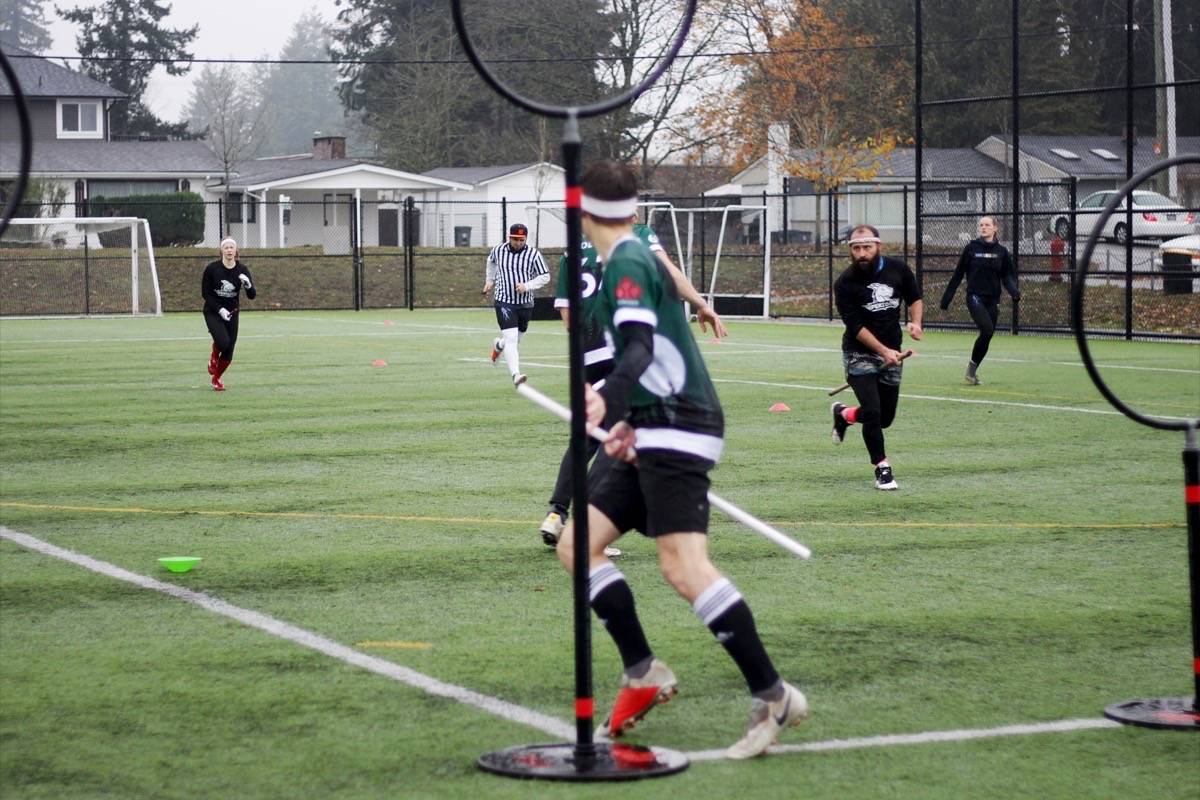When people see a real-life quidditch game, Nathan Ross says there are always three questions immediately.
“‘How do you fly? How does the snitch work? Do you guys have a deal with Warner Brothers?’ The answers are ‘No, we don’t fly. The snitch is a real person. And of course we don’t have a deal with Warner Brothers, or else we’d pay for this to be indoors, not in the rain,” said Ross, who is the captain and a beater for the Calgary Lightning team.
“But people are curious. There’s a lot of different aspects of every game; there’s football, there’s handball, there’s all kinds of games — tag, even. So people get curious and think, ‘I could do that.’ The answer is ‘Yes, you can.’ So when people come and talk to us, it’s a lot of, ‘Hey, we know this is funny and we know we look dumb, but we’re having a blast and you could have that much fun too.’”
Surrey’s Hjorth Road Park played host to Quidditch Canada’s Western Regional Championships Nov. 9 and 10. The tournament saw western teams competing for a spot in the national championships in Edmonton in the spring.
The Vancouver Storm Crows Quidditch Club won the regional championship, and will be moving on to the national tournament.
Quidditch is the real-life, full-contact sport based on the fictional game in J.K. Rowling’s Harry Potter series.
Quidditch Canada has 600 players on 22 teams.
Around the world, the Quidditch World Cup has been played in the U.K., Canada, Germany and Italy.
In the books, quidditch is played on flying broomsticks. Each goal is worth 10 points, and the game ends when the golden snitch – a ball with wings – is caught by the seeker, which is worth 150 points.
In real life, quidditch is played on the ground.
Rachel Malone, the Quidditch Canada national team program manager, said she helped start a quidditch team in Calgary and started coaching around 2013.
“It requires a lot of creativity because you have to figure out ways of borrowing drills from other teams,” she said. “Especially back in 2013 because quidditch was quite young and people were just learning to share knowledge. Nowadays, there’s a lot of excellent coaching resources that have been put together by various countries, national governing bodies.”
Malone said it’s always interesting when a new strategy is introduced by a team.
“One team will roll out this new strategy and everyone’s like, ‘Oh my gosh. What do I do? How do we counter this? We’ve never seen this before.’ And then very quickly people learn it and adjust. It’s a really dynamic sport.”
Like in the book version of quidditch, the teams consist of chasers, beaters, keepers and seekers. The equipment also includes a “quaffle,” “bludgers,” the snitch and a “broomstick,” like in the books.
“You have to be on broom the entire time, and in this case, our brooms are these PVC pipes that people have to keep between their legs,” Malone said.
The chasers and keepers, she said, wear green headbands.
“They’re going to be passing the volleyball around, which we call the ‘quaffle.’ They’re passing it between one another, trying to get it in one of three hoops. They get it through the hoops, 10 points for their team.”
The beaters use the bludgers (in this case a dodgeball) to hit players on the opposing team, Malone said.
“If they get hit with a dodgeball, they have to dismount off their broom, run back and touch the hoops and then they’re back in the game. So if they’re carrying any balls, things like that, then they’d also have to drop the ball,” she said. “So bludgers are great for stopping drives, forcing turnovers, things like that… They’re a really powerful tool. They offer one of the more chaotic elements of the game.”
Then at the 17th minute, the snitch runs onto the field, followed by the seekers at the 18th minute.
“So they’re going to be wearing a pair of special yellow shorts,” Malone said. “On the back of these yellow shorts is a tennis ball in a sock that is velcroed to the back. The seekers on each team, who are wearing the yellow headbands, come out on the field at 18 minutes and try to rip that sock off the tail of the snitch. That gets their team 30 points and ends the game.”
For Ross, he said as a player “it’s such a fun game.”
“The brooms are a wild aspect — it’s just a very comical aspect and it never gets old seeing players run around on brooms, like we’re choosing to do this and it’s absolutely wild.”
The quidditch community, Ross said, is also great.
“The reason why a lot of people like myself play is because there’s so many good people and it’s just a gender-inclusive game and I think there needs to be something like that where it’s full-contact, gender-inclusive game, the rules are meant to be so that you’ve gotta utilize your whole team, you’ve got to utilize everyone,” he said.
“There’s like three different games out there at once and you really have to get everyone involved… I love a good team, it just makes me so happy.”
READ ALSO: Quidditch teams to play ‘Harry Potter’-inspired sport in Surrey at regional tourney
lauren.collins@surreynowleader.com
Like us on Facebook Follow us on Instagram and follow Lauren on Twitter
